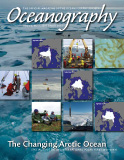Article Abstract
Could a gradual warming trend, combined with a large atmospheric or oceanic event, and mediated by Arctic-specific feedbacks, lead to persistent changes in Arctic climate? Several recent observed shifts follow this pattern: they are large, they occur across the Earth system, they are happening decades earlier than suggested by climate models, and while they may or may not be irreversible, they at least carry multiple-year memory (i.e., they are longer than the extreme event that was their proximate cause). When the 2007 summer sea ice minimum occurred, Arctic temperatures had been rising and sea ice had been decreasing over the previous two decades. Nevertheless, it took an unusually persistent southerly wind pattern over the summer months, and perhaps ocean transport and other factors, to initiate the loss event. The abrupt warming and associated record ice loss in West Greenland in 2010 also fit this hypothesis, initiated by southerly winds associated with an unusual manifestation of a natural climate pattern, the North Atlantic Oscillation. Extensive forest fires are causing deep burning of the soil layer, changing the carbon response of Arctic landmasses with lasting effects. Anomalous atmospheric circulation patterns in winter 2009–2010 and December 2010 linked cold-air outbreaks from the Arctic with mid-latitudes. While continued anthropogenic forcing predicts continued temperature increases and sea ice loss, these larger variations or “surprises” introduce uncertainties in the timing and magnitude of future Arctic shifts, the degree to which they are reversible or not, and how they will influence future local and global climate. Climate models, while imperfect, can be run multiple times, in series that are called “ensemble members,” to capture a range of potential responses to randomly occurring extreme events combined with continuing anthropogenic warming trends.

